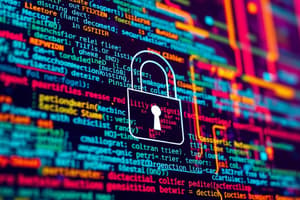Podcast
Questions and Answers
What does the term RPI refer to in the ControlLogix hardware environment?
What does the term RPI refer to in the ControlLogix hardware environment?
- Rapid Protocol Integration
- Requested Packet Interval (correct)
- Real-time Processing Indicator
- Remote Programmable Interface
What does a RED flashing 'OK' LED signify on a ControlLogix Processor?
What does a RED flashing 'OK' LED signify on a ControlLogix Processor?
- The processor requires a firmware update
- The processor is in standby mode
- The processor is operating normally
- The processor is in fault mode (correct)
What is the maximum number of characters allowed in a ControlLogix tag name?
What is the maximum number of characters allowed in a ControlLogix tag name?
- 64 characters
- 32 characters
- 128 characters
- 256 characters (correct)
In a TOF (Timer Off Delay) timer, what state is the (DN) bit in while the timer is actively timing?
In a TOF (Timer Off Delay) timer, what state is the (DN) bit in while the timer is actively timing?
What is the primary function of the RSLinx software?
What is the primary function of the RSLinx software?
How is a Latched Coil [OTL] functionally different from a normal Output Energize [OTE] Coil?
How is a Latched Coil [OTL] functionally different from a normal Output Energize [OTE] Coil?
What is the main purpose of a Subnet mask in networking?
What is the main purpose of a Subnet mask in networking?
What distinguishes Layer 2 switching from Layer 3 switching?
What distinguishes Layer 2 switching from Layer 3 switching?
Which command is used in ControlLogix to call a subroutine?
Which command is used in ControlLogix to call a subroutine?
What is the purpose of Static IP Addressing?
What is the purpose of Static IP Addressing?
Which tool is commonly used to ping another computer?
Which tool is commonly used to ping another computer?
What does the Open Loop command do in RMC?
What does the Open Loop command do in RMC?
In DeviceNet, which device is typically mapped first when configuring new devices?
In DeviceNet, which device is typically mapped first when configuring new devices?
What does the 'In Position' bit signify in RMC Win?
What does the 'In Position' bit signify in RMC Win?
Flashcards are hidden until you start studying
Study Notes
Networking Basics
- Multiple networks exist on-site, including specific networks for process control.
- Layer 2 switching operates at the data link layer, forwarding data based on MAC addresses; Layer 3 switching operates at the network layer, forwarding data based on IP addresses.
- A subnet mask is used to divide an IP address into a network and host portion, determining the network's size.
- DHCP (Dynamic Host Configuration Protocol) automatically assigns IP addresses and configurations to devices on a network.
IP Addressing
- Static IP addressing assigns a fixed IP to a device, ensuring consistent identification on a network.
- Information on installed components and devices can be found in system settings or device manager on a PC.
Remote Access and Control
- Remote PCs at Raymond can be connected via VPN, Remote Desktop Protocol (RDP), or terminal services.
- An array is a data structure that can hold multiple values in a single variable, often used in programming.
- A Dint (double integer) is a 32-bit data type used in programming for numerical values.
- A Bool represents a boolean value (true/false) in programming.
- A UDT (User-Defined Type) is a custom data structure created by users for specific needs in programming.
Networking Tools and Diagnostics
- The ping command tests the connectivity between computers on a network by sending ICMP packets.
- Pinging a computer is done to check if it is reachable and to measure response time.
- Default Gateway serves as the access point for devices to communicate with external networks.
Control Systems
- Two networks for process control at Raymond include DeviceNet and EtherNet/IP.
- Specific communication cards are designated for VFDs (Variable Frequency Drives) in different protocols.
- E3 devices identify active faults through built-in diagnostic capabilities.
Software and Configuration
- Various Logix versions are utilized on-site for control systems and automation.
- RMC (Robot Motion Control) Open Loop command sets operation without positional feedback.
- RMC software settings, including extend and retract limits for cylinders, should be set conservatively.
- Base IO tags in ControlLogix are structured with a specific syntax, found in the Controller Organizer of Studio-5000/RSLogix-5000.
ControlLogix Functionality
- RPI (Requested Packet Interval) in ControlLogix denotes the time interval for communication packets.
- A RED flashing "OK" LED on a ControlLogix Processor indicates a fault state.
- ControlLogix tag names are limited to a specific number of characters, ensuring clarity and organization.
- RSLinx software serves as a communication interface between PLCs and software applications.
Programming Logic
- Deleting a rung containing a coil leaves the associated bit in an indeterminate state.
- The DN (Done) bit for a TOF (Timer Off Delay) timer is set to 1 (on) while timing is active.
- A latched coil maintains its last state even after the logic that activated it goes inactive, unlike a standard output energize coil.
- Timers have a maximum preset value that depends on the time base utilized.
- The RES (Reset) instruction is required for certain timer instructions to reset their state.
- Accidental program logic edits are prevented in Allen-Bradley systems through safety measures to ensure system integrity.
Studying That Suits You
Use AI to generate personalized quizzes and flashcards to suit your learning preferences.




